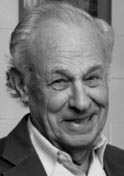- Undergraduate
Bachelor's Degrees
Bachelor of ArtsBachelor of EngineeringPartner School Dual-DegreeUndergraduate AdmissionsUndergraduate Experience
- Graduate
Doctoral Degrees
Doctor of PhilosophyPhD Innovation ProgramDoctor of Medicine-PhDGraduate AdmissionsGraduate Experience
- Research
- Entrepreneurship
- Community
- About
-
All Thayer News

Millett Granger Morgan
Professor Millett Morgan
Mar 04, 2011
CONTACT: Catharine Lamm
603/646-3943
Professor Millett G. Morgan, founder of the Radiophysics Laboratory at Dartmouth’s Thayer School of Engineering, and a leading researcher in the field of ionospheric physics, died on January 14 at the Dartmouth-Hitchcock Medical Center in Hanover, New Hampshire after suffering a heart attack and a stroke.

Millett Granger Morgan
In the early 1950s Prof. Morgan established a research program to use the newly discovered phenomena of naturally occurring audio-frequency radio waves produced by lightening and the aurora as a tool to study the properties of space plasma in the vicinity of the earth, a region now known as the upper ionosphere and the magnetosphere. These studies made it possible to gain insights about the properties of this region of near-earth space in the years before space craft began to make direct observations. Prof. Morgan recorded the naturally occurring signals, referred to by descriptive names such as "whistlers" and "dawn chorus," at a network of receiving stations, and interpreted them to obtain some of the earliest measurements of the density of free electrons many thousands of kilometers above the earth. His work provided experimental foundations for early studies of how the earth and its magnetic field interact with the solar wind.
During the International Geophysical Year (IGY, 1957-8) Prof. Morgan chaired the US National Committee's Panel on Ionospheric Research of the National Research Council, which oversaw radio studies conducted all around the earth. In early 1958 he joined the re-supply mission to the US Antarctic station on the Weddell Sea as the senior scientific representative. In his own IGY research he maintained an extensive series of stations throughout the Americas.
In studies in the late 1940s and early 1950s, at a field station that he established near his home in Hanover, New Hampshire, Prof. Morgan and his colleagues conducted radar studies to experimentally observe the two modes of propagation which magnetoionic theory predicted would occur when a radio wave enters the ionosphere. In the 1980s Professor Morgan built a network of radar observing stations to conduct studies of gravity waves that propagate to lower latitudes from the arctic. The waves appear as propagating undulations in the lower layers of the ionosphere.
A long-time "ham" radio operator (W1HDA), Morgan first developed his life-long interest in radio as a teenager, growing up in Hanover, New Hampshire. He studied at the Clark School in Hanover, where his father, mathematician Frank M. Morgan was head master. He earned a B.A. in Physics in 1937 and an M.Sc. in Electrical Engineering in 1938 at Cornell University. He began further graduate studies in electrical engineering at Stanford and earned the "Engineer" degree in 1939. He interrupted his graduate studies during the Second World War to work on the development of x-band radars for destroyer escort vessels at the Submarine Signal Company in Boston, MA, and to develop radar counter measures at the California Institute of Technology in Pasadena, CA. In 1946 he completed his Ph.D. in electrical engineering at Stanford. After a year in the Naval Antenna Group at UC Berkeley, in 1947 he joined the faculty of the Thayer School of Engineering at Dartmouth College where he continued for the balance of his career. In 1971 he became the first occupant of the Sydney E. Junkins Professorship.
Prof. Morgan is widely credited with leading the early development of graduate research at the Thayer School where he and his colleagues and graduate students ran an active program of research and published widely in the scientific literature. For many years he taught courses in electromagnetic field theory, antenna design, magnetoionospheric physics and related topics.
Prof. Morgan was an avid outdoorsman. During the summers of 1935 and 1936, he served as Assistant Hut Master at Greenleaf Hut operated by the Appalachian Mountain Club on Mount Lafayette in the White Mountains of New Hampshire. He remained an active hiker, climbing many mountains in the US and Europe with members of his family. He was also active in the early skiing community in Hanover, and he founded and coached the Cornell ski team. Throughout his life he traveled extensively, usually with his family. In later years he developed a strong interest in opera, and made frequent trips with his wife, other family members, and friends, to attend opera performances in the US and in Europe.
Prof. Morgan was a fellow of the Institute of Electrical and Electronic Engineers (IEEE, formerly the IRE), a member of the American Geophysical Union, and of Sigma Xi, the Scientific Research Society.
Prof. Morgan married Eleanor Walbridge of Enfield, New Hampshire in 1937. He is survived by his beloved wife of sixty-five years, and their four children: M. Granger Morgan of Pittsburgh PA; Deborah Morgan Olsen of Tigard, OR; Janet E. Morgan of Ithaca, NY; and Jessica Ryder (formerly Beverly S. Morgan) of North Attleboro, MA. He is also survived by five grandchildren and three great-grandchildren.
In lieu of flowers, donations in Professor Morgan's name may be made to Opera North and/or:
Thayer School of Engineering
c/o Student Activities Fund
Dartmouth College
14 Engineering Drive
Hanover, NH 03755
For contacts and other media information visit our Media Resources page.
